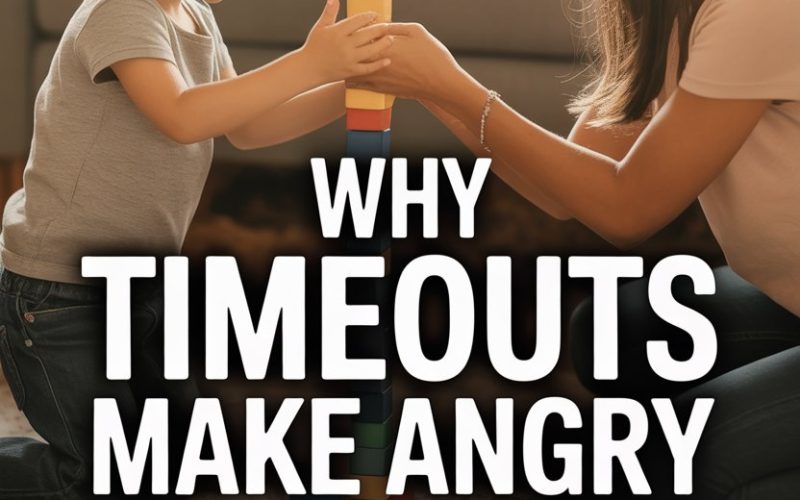If you’ve ever stood outside a locked bathroom door while your child howled from the other side, clutching an egg timer and a prayer, you already know that timeouts can sometimes feel more like a parenting punishment than a learning experience for the child.
You’re not alone.
The truth is, timeouts aren’t the magic fix they’ve been cracked up to be—especially for angry, out-of-control kids.
Why Timeouts Miss the Mark With Angry Kids
Picture this: Your little one has just hurled a train across the room (again), and your nerves are shot.
Out comes the “timeout” card—two minutes per year of age, or whatever the latest advice says. They stomp off (or you carry them, Olympic wrestler-style), and the battle lines are drawn.
When children are already angry, sending them away to stew rarely calms them down. Their brains are in ‘threat mode,’ flooded with stress hormones. Neuroscientists call this amygdala hijack.
Rational thought has left the building. What’s left? Fight or flight.
Here’s the problem: isolation can feel like rejection to a child—especially if they’re in a red-hot emotional state. Instead of teaching self-regulation, the timeout can supercharge their anger, triggering shame, resentment, or just a bigger meltdown.
Research from the University of Michigan’s Child Emotion Lab shows that when kids are sent away in distress, they may internalize the message: “You’re only wanted when you’re calm.”
No wonder the whole process feels like a gamble.
What Angry Kids Are Really Telling You
Anger is a tricky beast. It’s rarely the true emotion—it’s more like the smoke, not the fire. Beneath a child’s rage often lurk feelings of fear, embarrassment, frustration, or sadness.
When your six-year-old is screaming about “unfair rules” or the tragic demise of his biscuit, he’s really saying, “I’m overwhelmed and I don’t know how to cope!”
Traditional timeouts don’t teach coping. They just press pause—on connection and on learning.
Clinical psychologist Dr. Mona Delahooke, author of Beyond Behaviors, suggests that children’s meltdowns are signals of unmet needs, not willful disobedience.
When we respond with isolation, it’s like sticking a plaster on a leaky pipe.
Why Connection Calms the Storm
Do you remember a time you were furious and someone said, “Go to your room and come back when you’re calm”? No? That’s because adults get to vent, talk, or at least text their mates in a rage.
Children need the same thing, only more so. Their brains are still under construction, especially in the “self-control” and “problem-solving” departments.
What they really need is co-regulation—that’s a fancy way of saying they borrow your calm when they’ve lost theirs.
Stanford psychologist Dr. Laura Markham, founder of Aha! Parenting, explains that connecting with a dysregulated child helps them feel safe, which is the first step to calming down.
It doesn’t mean you’re letting them “get away with it.” You’re teaching emotional literacy, not just crowd control.
The Calm-Down Alternative: Connection Time
Here’s a strategy that can change the whole game: Instead of sending your child away, try inviting them closer for ‘connection time.’
This doesn’t mean ignoring bad behaviour. Boundaries are still crucial. Connection time is about creating a safe space for your child to ride out their feelings with you nearby.
- Get down on their level and speak gently: “I can see you’re really angry right now. I’m here with you.”
- Offer a hug—if they want it. Some angry kids need physical comfort, while others need space (but not isolation).
- Name the emotion: “You’re angry because you had to stop playing. That’s tough.”
- Breathe together. Slow breathing (even if you’re the only one doing it at first) sends ‘safety signals’ to your child’s brain.
Is it always neat? Not a chance. Some days you’ll feel like a human punchbag. But over time, your child learns that feelings aren’t dangerous, and neither are you.
Teach Emotional Skills, Not Just Compliance
Anger in kids is often a sign that they’re missing the skills to cope with big emotions. Rather than punishing the outburst, focus on teaching.
This isn’t always quick and rarely comes with a tidy soundtrack, but the payoff is huge.
- Model emotional language: “I’m frustrated too, but I’m trying to stay calm.”
- Role-play problem-solving: “When you feel angry, what could you do instead of throwing?”
- Praise effort, not perfection: “You used your words! That took a lot of courage.”
Psychologist Dr. Ross Greene’s work in Collaborative and Proactive Solutions shows that kids do well if they can.
If they’re lashing out, it’s because something’s getting in the way. Skill-building beats punishment every time.
Repair Beats Rejection
Timeouts can drive a wedge between parent and child, especially if used often or as a go-to for all offenses. Angry kids need to know that relationships can weather big feelings.
Mess up, make amends, move on.
When the dust settles, talk through what happened:
- “I saw you were really mad when your sister took your toy. Next time, what could we do?”
- “I got a bit shouty too. Sorry about that. Can we have a do-over?”
Children who learn that mistakes aren’t the end of the world become more resilient. You’re teaching them the art of repair—a skill that’ll outlast any egg timer.
Make a Calm Corner (Not a Lonely One)
If you need a practical tool beyond just presence, try creating a ‘calm corner’ at home. Unlike the old-school “naughty step,” this spot is for everyone (yes, you too on dodgy Mondays).
Fill it with soft cushions, stress balls, sensory toys, or books. The idea is to show your child that calming down is something everyone needs now and then, and it’s not a punishment.
Invite your child to join you there when things heat up, or let them choose it themselves.
This tactic works because it’s about self-care, not banishment. The message? “Big feelings are normal.
Here’s a place to help you through.”
When to Get Extra Help
Sometimes, a child’s anger tips into aggression that’s hard to manage with connection and calm-down corners alone.
If your child’s outbursts are daily, include violence, or don’t improve after a stretch of trying these strategies, it’s time to call in backup.
Reach out to your GP or a child psychologist. They can rule out underlying issues like anxiety, sensory difficulties, or trauma, and help craft a plan that fits your family.
You’re not failing. You’re taking care of everyone—including yourself.
Connection Is the Shortcut, Not the Detour
Timeouts might buy a few minutes of peace (and occasionally save the family cat), but they don’t teach what angry kids truly need: how to handle big emotions with help, not shame.
By swapping isolation for connection, you’re building your child’s emotional toolkit—and keeping your relationship intact.
Meltdowns won’t vanish overnight, but you’ll find more cooperation, less resentment, and maybe even a bit less yelling (from everyone).
Besides, who doesn’t need a cuddle and a do-over once in a while?
Go on—ditch the egg timer. Your child’s heart (and brain) will thank you.





